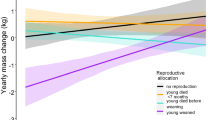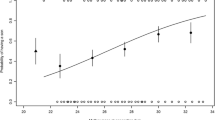Summary
We examined maternal energy expenditure in Rocky Mountain bighorn sheep to test the hypothesis (Trivers and Willard 1973) that individual sons in polygynous mammals should obtain a larger maternal subsidy. In accord with theory, males weighed more at birth (an index of relative prenatal expenditure), tended to suckle more between 40 and 100 days of age (an index of relative postnatal expenditure) and imposed greater delays on their mothers' return to estrus in the subsequent breeding season (an index of relative total preweaning expenditure). Mothers rather than offspring appeared to have primary control over postnatal expenditure. The effect of maternal reproductive effort on return to estrus was cumulative over a period of 3–5 years so that ewes making relatively large expenditures gave birth progressively later. Ewe and lamb mortality was associated with late conception in the previous rut. Thus, differential reproductive effort by ewes in this population appeared to entail a fitness cost involving reductions in both offspring and maternal survivorship.
Similar content being viewed by others
References
Barber N (1991) Play and energy regulation in mammals. Q Rev Biol 66:129–147
Berger J (1979a) Social ontogeny and behavioural diversity: consequences for bighorn sheep (Ovis canadensis) inhabiting desert and mountain environments. J Zool London 188:251–266
Berger J (1979b) Weaning conflict in desert and mountain bighorn sheep (Ovis canadensis): an ecological interpretation. Z Tierpsychol 50:188–200
Blood DA, Flook DR, Wishart WD (1970) Weights and growth of Rocky Mountain bighorn sheep in Western Alberta. J Wildl Manage 34:451–455
Borer KT (1987) How running accelerates growth. Prog Psychobiol 12:47–115
Byers JA, Bekoff M (1990) Inference in social evolution theory: a case study. In: Bekoff M, Jamieson D (eds) Interpretation and explanation in the study of animal behavior: Vol. 2: Explanation, evolution and adaptation. Westview Press, Boulder, pp 84–97
Byers JA, Moodie JD (1990) Sex-specific maternal investment in pronghorn, and the question of a limit on differential provisioning in ungulates. Behav Ecol Sociobiol 26:157–164
Charnov EL (1979) The genetical evolution of patterns of sexuality: Darwinian fitness. Am Nat 113:465–480
Charnov EL (1982) The theory of sex allocation. Princeton University Press, Princeton
Clark AB (1978) Sex-ratio and local resource competition in a prosimian primate. Science 201:163–165
Clutton-Brock TH (1991) The evolution of parental care. Princeton University Press, Princeton
Clutton-Brock TH, Albon SD, Guinness FE (1982b) Competition between female relatives in a matrilocal mammal. Nature 300:178–180
Clutton-Brock TH, Guinness FE, Albon SD (1982b) Red Deer: Behavior and Ecology of the Two Sexes. University of Chicago Press, Chicago
Dawkins R, Krebs JR (1979) Arms races between and within species. Proc R Soc London B 205:489–511
Draper NR, Smith H (1981) Applied regression analysis, 2nd edn. John Wiley, New York
Estes RD (1976) The significance of breeding synchrony in the wildebeest. E Afr Wildl J 14:135–152
Festa-Bianchet M (1988a) Age-specific reproduction of bighorn ewes in Alberta, Canada. J Mammal 69:157–160
Festa-Bianchet M (1988b) Birthdate and survival in bighorn lambs (Ovis canadensis). J Zool London 214:653–661
Festa-Bianchet M (1988c) Nursing behaviour of bighorn sheep: correlates of ewe age, parasitism, lamb age, birthdate and sex. Anim Behav 36:1445–1454
Festa-Bianchet M (1989a) Individual differences, parasites, and the costs of reproduction for bighorn ewes (Ovis canadensis). J Anim Ecol 58:785–795
Festa-Bianchet M (1989b) Survival of male bighorn sheep in Southwestern Alberta. J Wildl Manage 53:259–263
Festa-Bianchet M (1991) The social system of bighorn sheep: grouping patterns, kinship and female dominance rank. Anim Behav 42:71–82
Frisch RE (1984) Body fat, puberty and fertility. Biol Rev 59:161–188
Geist V (1966) Validity of horn segment counts in aging bighorn sheep. J Wildl Manage 30:634–635
Geist V (1971) Mountain sheep: a study in behavior and evolution. University of Chicago Press, Chicago
Guinness FE, Albon SD, Clutton-Brock TH (1978b) Factors affecting reproduction in red deer (Cervus elaphus). J Reprod Fert 54:325–334
Guinness FE, Clutton-Brock TH, Albon SD (1978b) Factors affecting calf mortality in red deer. J Anim Ecol 47:817–832
Guinness FE, Gibson RM, Clutton-Brock TH (1978c) Calving times of red deer (Cervus elaphus) on Rhum. J Zool London 185:105–114
Gunn RG, Doney JM (1975) The interaction of nutrition and body condition at mating on ovulation rate and early embryo mortality in Scottish blackface ewes. J Agric Sci 85:465–470
Hansen CG (1965) Growth and development of desert bighorn sheep. J Wildl Manage 29:387–391
Hass CC (1986) Play behavior and dominance relations of bighorn sheep on the National Bison Range. M.A. Dissertation, University of Montana
Hass CC (1989) Bighorn lamb mortality: predation, inbreeding and population effects. Can J Zool 67:699–705
Hass CC (1990) Alternative maternal care patterns in two herds of bighorn sheep. J Mammal 71:24–35
Hogg JT (1984) Mating in bighorn sheep: multiple creative male strategies. Science 225:526–529
Hogg JT (1987) Intrasexual competition and mate choice in Rocky Mountain bighorn sheep. Ethology 75:119–144
Hogg JT (1988) Copulatory tactics in relation to sperm competition in Rocky Mountain bighorn sheep. Behav Ecol Sociobiol 22:49–59
Horejsi B (1976) Suckling and feeding behaviour in relation to lamb survival in bighorn sheep (Ovis canadensis canadensis Shaw). PhD. Dissertation, University of Calgary Jorgenson JT, Wishart WD (1984) Growth rates of Rocky Mountain bighorn sheep on Ram Mountain, Alberta. In: Proceedings of the Northern Wild Sheep and Goat Council, Whitehorse, Yukon Territory, pp 270–284
Maynard-Smith J (1980) A new theory of sexual investment. Behav Ecol Sociobiol 7:247–251
Miller MN, Byers JA (1991) Energetic cost of locomotor play in pronghorn fawns. Anim Behav 41:1007–1013
Mitchell B, Lincoln GA (1973) Conception dates in relation to age and condition in two populations of red deer in Scotland. J Zool London 171:141–152
Mitchell B, McCowan D, Nicholson IA (1976) Annual cycles of body weight and condition in Scottish red deer, Cervus elaphus. J Zool London 180:107–127
Norusis MJ (1988) SPSS/PC+ V2.0 for the IBM PC/XT/AT and PS2. SPSS Inc., Chicago
Oftedal OT (1985) Pregnancy and lactation. In: Hudson RJ, White RG (eds) Bioenergetics of wild herbivores. CRC Press, Boca Raton, Florida, pp 215–238
Reznick D (1985) Costs of reproduction: an evaluation of the empirical evidence. Oikos 44:257–267
Rutberg AT (1987) Adaptive hypotheses of birth synchrony in ruminants: an interspecific test. Am Nat 130:692–710
Sadlier R (1969) The ecology of reproduction in wild and domestic mammals. Methuen, London
Schallenberger AD (1972) Management and research on bighorn sheep, Sun River Area, Montana. In: Proceedings of the Northern Wild Sheep and Goat Council, Hinton, Alberta, pp 2–15
Schindler H, Amir D (1972) Length of oestrus, duration of phenomena related to oestrus, and ovulation time in the local fattailed Awassi ewe. J Agric Sci 78:151–156
Shackleton DM, Haywood J (1985) Early mother-young interactions in California bighorn sheep, Ovis canadensis californiana. Can J Zool 65:868–875
Sibly RM, Calow P (1986) Physiological ecology of animals: an evolutionary approach. Blackwell, Boston
Sokal RR, Rohlf FJ (1981) Biometry. Freeman, San Francisco
Thorne T, Butler G, Varcalli T, Becker K, Hayden-Wing S (1979) The status, mortality and response to management of the bighorn sheep of Whiskey Mountain. (Wildlife Technical Report Number 7.) Wyoming Game and Fish Department, Cheyenne
Trivers RL, Willard DE (1973) Natural selection of parental ability to vary the sex ratio of offspring. Science 179:90–92
Willson MF, Pianka ER (1963) Sexual selection, sex ratio and the mating system. Am Nat 97:405–407
Author information
Authors and Affiliations
Additional information
Correspondence to: J.T. Hogg at the present address
Rights and permissions
About this article
Cite this article
Hogg, J.T., Hass, C.C. & Jenni, D.A. Sex-biased maternal expenditure in Rocky Mountain bighorn sheep. Behav Ecol Sociobiol 31, 243–251 (1992). https://doi.org/10.1007/BF00171679
Received:
Accepted:
Issue Date:
DOI: https://doi.org/10.1007/BF00171679




